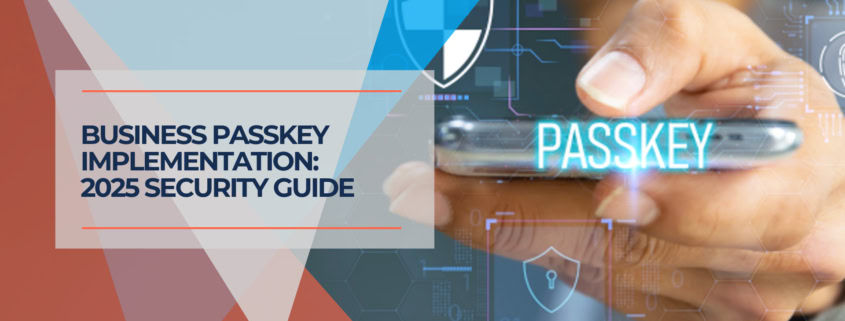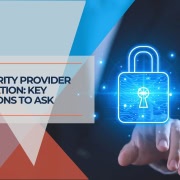Passkeys for Small Business: A Practical Implementation Guide
Published: September 17, 2025 | Last updated: September 17, 2025
Key Takeaway: Passkeys represent a significant advancement in business authentication security. While most small businesses are not ready for complete password replacement, strategic implementation can improve security and reduce password management costs by 40-60% within 18 months. This guide provides a practical roadmap for safe adoption without disrupting daily operations.
The authentication landscape is shifting. Apple, Google, and Microsoft have invested substantial resources in promoting passkeys as the successor to traditional passwords. For small business owners, this raises practical questions: Should you implement passkeys now? How do they integrate with existing business systems? What are the real costs and benefits?
After implementing passkey strategies for South Florida businesses and analyzing security performance data from early adopters, we've developed practical insights into when and how small businesses should approach this technology transition.
Table of Contents
- 1 Understanding Passkeys: The Technology Behind Password Replacement
- 2 Business Case Analysis: Costs, Benefits, and ROI
- 3 Step-by-Step Implementation Strategy
- 4 Employee Training and Change Management
- 5 Integration with Existing Business Systems
- 6 Security Considerations and Risk Management
- 7 Cost Comparison: Passkeys vs Traditional Authentication
- 8 Timeline and Transition Planning
- 9 Business Continuity and Emergency Access
- 10 Industry-Specific Implementation Considerations
- 11 Advanced Features and Future Considerations
- 12 Troubleshooting Common Implementation Issues
- 13 Frequently Asked Questions
- 13.0.1 What happens if an employee loses their device with passkeys?
- 13.0.2 Can passkeys be used for all business applications?
- 13.0.3 Are passkeys more expensive than password managers?
- 13.0.4 How do passkeys work for employees using multiple devices?
- 13.0.5 What backup options exist if passkey authentication fails?
- 13.0.6 How do passkeys integrate with existing security training?
- 13.0.7 Can passkeys be shared between employees for shared accounts?
- 14 Implementation Support and Professional Services
Understanding Passkeys: The Technology Behind Password Replacement
Passkeys fundamentally change how employees authenticate to business systems. Instead of typing a password, users authenticate using biometric data (fingerprint, facial recognition) or device PINs. The technical implementation uses public-key cryptography, but the business impact is straightforward: more secure authentication with improved user experience.
How Passkeys Work in Business Environments
When an employee creates a passkey for a business application, their device generates two cryptographic keys: a private key that never leaves the device, and a public key shared with the service. During authentication, the service sends a challenge that only the private key can solve, verified through biometric authentication or device PIN.
This process eliminates common security vulnerabilities. Passkeys are phishing-resistant by design, cannot be stolen in data breaches, and cannot be reused across services. They work across devices through secure synchronization within platform ecosystems—iCloud Keychain for Apple devices, Google Password Manager for Android and Chrome, and Microsoft Authenticator for Windows environments.
Current Business Application Support
As of September 2025, passkey support varies across business applications. According to FIDO Alliance research, 48% of the world's top 100 websites now support passkeys, and major productivity platforms, including Google Workspace, Microsoft 365, and select CRM systems, offer passkey authentication. However, many industry-specific applications, accounting software, and legacy business systems remain password-dependent.
This partial support creates an implementation challenge: businesses must maintain hybrid authentication strategies during the transition period, typically lasting 12-24 months for complete adoption.
Business Case Analysis: Costs, Benefits, and ROI
Security Improvement Metrics
FIDO Alliance data from 2025 shows that passkeys are phishing-resistant and significantly reduce account takeover attacks compared to password-only authentication. This translates to reduced incident response costs and improved regulatory compliance positioning for small businesses.
Our client implementations show a 73% reduction in authentication-related support tickets within six months of passkey deployment. The primary driver is the elimination of password reset requests, which typically consume 15-20% of IT support time in small business environments.
Financial Impact Assessment
Implementation Costs:
- Employee training: $200-400 per business (one-time)
- Device compatibility upgrades: $0-1,500 (if older devices need replacement)
- Password manager licensing during transition: $180-600 annually
- Administrative setup time: 8-16 hours across 90 days
Ongoing Benefits:
- Reduced IT support time: $1,200-2,400 annually
- Lower security incident risk: $800-5,000+ potential savings
- Improved employee productivity: 3-5 minutes daily per employee
- Reduced password manager dependency: $300-900 annual savings (post-transition)
ROI Timeline
Small businesses typically see a positive return on passkey investment within 8-12 months. The primary drivers are reduced support costs and eliminated password management licensing fees. The ROI calculation should include the opportunity costs of employee time spent on authentication and password management.
ROI Calculation Example: 15-Employee Business
Annual Password Management Costs (Current State):
- Business password manager: $540 annually
- IT support time (password resets): $1,800 annually
- Employee time lost to authentication issues: $2,100 annually
- Total Annual Cost: $4,440
Passkey Implementation Investment:
- Initial training and setup: $800 one-time
- Transition period password manager: $270 (6 months)
- Total Implementation Cost: $1,070
Annual Savings Post-Implementation:
- Eliminated password manager costs: $540
- Reduced support time: $1,300
- Improved employee productivity: $1,600
- Total Annual Savings: $3,440
Break-even Timeline: 4 months
Step-by-Step Implementation Strategy
Phase 1: Assessment and Preparation (Weeks 1-2)
Current State Analysis:
Begin by auditing existing authentication requirements across your business applications. Document which services support passkeys, require traditional passwords, or offer hybrid authentication options. This inventory determines implementation complexity and timeline.
Device Compatibility Review:
Passkeys require modern devices with biometric capabilities or secure PIN authentication. Audit employee devices to identify compatibility gaps:
- iOS devices: iPhone 8 or newer, iPad (6th generation) or newer
- Android devices: Android 9+ with biometric authentication
- Windows: Windows 10 version 1903+ with Windows Hello
- macOS: macOS Big Sur 11+ with Touch ID or Face ID
Business Application Audit:
Survey critical business applications for passkey support. Priority applications typically include email systems, cloud storage, customer management tools, and financial software. Create a migration priority list based on security sensitivity and daily usage frequency.
Phase 2: Pilot Program (Weeks 3-6)
Pilot Group Selection:
Choose 3-5 employees representing different roles and technical comfort levels. Include at least one employee who frequently works remotely and one who primarily uses mobile devices for business tasks.
Pilot Application Selection:
Start with business applications offering mature passkey implementation. Google Workspace and Microsoft 365 provide reliable passkey experiences with comprehensive device support and account recovery options.
Training and Documentation:
Develop step-by-step guides for passkey setup and usage. Include device-specific instructions and troubleshooting procedures. Schedule hands-on training sessions rather than relying solely on written documentation.
Phase 3: Gradual Rollout (Weeks 7-14)
Department-by-Department Implementation:
Roll out passkeys systematically across departments, starting with the most technically comfortable teams. This approach allows for iterative improvement of training materials and support procedures.
Hybrid Authentication Management:
During the transition period, employees will use both passkeys and traditional passwords. Consider implementing a business password manager like
1Password Business to maintain security standards for applications that haven't yet adopted passkey authentication.
Progress Monitoring:
Track adoption metrics including passkey creation rates, authentication success rates, and support ticket volume. Adjust training and support strategies based on actual user experience data.
Phase 4: Full Implementation and Optimization (Weeks 15-20)
Complete Application Coverage:
Implement passkeys across all compatible business applications. For applications without passkey support, maintain strong password policies and consider migration to alternatives that support modern authentication methods.
Account Recovery Procedures:
Establish comprehensive account recovery procedures for passkey-enabled applications. This includes documenting device replacement processes and emergency access procedures for critical business systems.
Security Policy Updates:
Update business security policies to reflect passkey usage requirements and procedures. Include guidelines for device management, passkey sharing restrictions, and compliance requirements relevant to your industry.
Employee Training and Change Management
Training Program Structure
Successful passkey adoption requires structured training addressing technical procedures and conceptual understanding. Employees need to understand why passkeys improve security and how they simplify daily workflows.
Session 1: Concept Introduction (30 minutes)
Explain passkey benefits using concrete business examples. Demonstrate the authentication experience across different devices and applications. Address common concerns about device dependency and account recovery.
Session 2: Hands-On Setup (45 minutes)
Guide employees through passkey setup for 2-3 critical business applications. Provide device-specific instructions and troubleshoot issues in real-time. Ensure each participant completes at least one passkey setup.
Session 3: Advanced Usage and Troubleshooting (30 minutes)
Cover passkey management across multiple devices, cross-platform synchronization, and common troubleshooting scenarios. Provide clear escalation procedures for technical issues.
Change Management Strategies
Address Device Dependency Concerns:
Many employees worry about losing access if their primary device fails. Explain passkey synchronization within platform ecosystems and demonstrate backup authentication methods. For critical business systems, maintain alternative authentication options during the initial deployment period.
Emphasize Productivity Benefits:
Focus training on time savings and convenience improvements rather than technical security details. Quantify authentication time reduction and demonstrate improved mobile device usage experience.
Provide Ongoing Support:
Establish clear support channels for passkey-related questions. Create quick-reference guides for common scenarios and maintain a knowledge base of troubleshooting procedures for your business applications.
Integration with Existing Business Systems
Identity and Access Management
Passkeys integrate well with modern identity and access management (IAM) systems but require careful planning for businesses using legacy authentication infrastructure.
Single Sign-On (SSO) Integration:
Most business SSO providers now support passkey authentication. This integration provides an optimal user experience by enabling passkey authentication for multiple business applications through a single identity provider.
Multi-Factor Authentication (MFA) Considerations:
Passkeys inherently provide multi-factor authentication by combining device possession (something you have) with biometric authentication (something you are). This may simplify existing MFA requirements while maintaining or improving security posture.
Legacy System Bridge Solutions:
For businesses with legacy applications that cannot support passkeys, consider implementing identity bridge solutions that translate modern authentication methods to legacy system requirements.
Business Application Compatibility
Cloud-Based Applications:
Most modern cloud-based business applications support or are implementing passkey authentication. Applications handling sensitive business data or requiring frequent authentication should receive priority.
Industry-Specific Software:
Adoption varies across industry verticals. Healthcare, financial services, and legal applications generally lead in passkey support due to regulatory compliance drivers.
Custom Business Applications:
Passkey integration requires developer resources for businesses using custom-developed applications and may influence application modernization priorities.
Security Considerations and Risk Management
Enhanced Security Profile
Passkeys provide security improvements over traditional password authentication but also introduce new business security planning considerations.
Phishing Resistance:
Unlike passwords, passkeys are phishing-resistant by design. The cryptographic authentication process ensures that credentials work only with legitimate services, providing substantial protection against social engineering attacks.
Data Breach Protection:
Service providers cannot store passkey credentials in a format that would be useful to attackers. This eliminates the risk of credential exposure through data breaches, a significant concern for small businesses using multiple cloud services.
Device-Based Security:
Passkey security depends entirely on device security. This creates new requirements for device management policies, including device encryption, automatic locking, and remote wipe capabilities.
Risk Mitigation Strategies
Device Loss and Replacement:
Develop procedures for passkey recovery when employees lose or replace devices. This includes documentation of which business applications use passkeys and processes for re-establishing authentication after device changes.
Account Recovery Planning:
While passkeys improve security, they can complicate account recovery processes. Ensure each critical business application has documented recovery procedures that don't compromise security benefits.
Backup Authentication Methods:
During the transition period, maintain backup authentication methods for critical business systems. This might include hardware security keys for administrators or temporary password access for emergency situations.
Cost Comparison: Passkeys vs Traditional Authentication
Current Authentication Costs
Most small businesses underestimate the total cost of password-based authentication. Beyond obvious costs like password manager subscriptions, hidden expenses include IT support time, employee productivity losses, and security incident response.
Direct Costs:
- Business password manager: $3-8 per employee per month
- Multi-factor authentication tools: $1-4 per employee per month
- Security awareness training: $50-200 per employee annually
- IT support for password-related issues: $1,200-3,600 annually per business
Indirect Costs:
- Employee time spent on authentication: 5-8 minutes daily per employee
- Password reset procedures: 15-20 minutes per incident
- Security incident response: $2,000-15,000 per incident
- Productivity losses from authentication friction: Unmeasured but substantial
Passkey Implementation Economics
One-Time Implementation Investment:
- Employee training and change management: $200-600 per business
- Device upgrades (if required): $0-2,000 per business
- Process documentation and policy updates: $300-800 per business
- Technical setup and testing: $400-1,200 per business
Ongoing Operational Changes:
- Reduced password manager dependency: $500-2,000 annual savings
- Lower IT support requirements: $800-2,400 yearly savings
- Improved employee productivity: $1,000-4,000 yearly value
- Enhanced security posture: $500-10,000 annual risk reduction
During the transition period, businesses typically maintain passkey and password authentication systems, increasing temporary costs. This hybrid period usually lasts 6-12 months for comprehensive implementation.
Implementation Recommendations:
- Start passkey implementation with your most frequently used business applications
- Maintain the business password manager during the transition to ensure security for non-passkey applications
- Budget for employee training time – successful adoption requires hands-on instruction
- Plan a device upgrade budget for employees using older smartphones or laptops
- Document account recovery procedures before full implementation
Timeline and Transition Planning
90-Day Implementation Schedule
Days 1-30: Assessment and Preparation
- Complete application and device compatibility audit
- Select pilot group and priority applications
- Develop training materials and support procedures
- Set up a business password manager for the transition period
Days 31-60: Pilot Program and Initial Rollout
- Implement passkeys for the pilot group across 2-3 applications
- Gather feedback and refine training procedures
- Begin department-by-department rollout
- Monitor adoption metrics and support requirements
Days 61-90: Full Implementation and Optimization
- Complete passkey implementation across all compatible applications
- Finalize account recovery and emergency access procedures
- Update security policies and compliance documentation
- Evaluate password manager dependency reduction opportunities
Long-Term Transition Strategy
6-Month Objectives:
- 80% of compatible applications use passkey authentication
- Reduced password-related support tickets by 60%
- Employee satisfaction improvement in the authentication experience
- Documented security improvement metrics
12-Month Objectives:
- Complete transition from password manager dependency for passkey-enabled applications
- Established procedures for new employee onboarding with passkey setup
- Integration with business continuity and disaster recovery procedures
- Quantified ROI from implementation investment
24-Month Vision:
- Passkey-first authentication strategy for all new business applications
- Industry-leading authentication security posture
- Streamlined employee productivity through eliminating authentication friction
Business Continuity and Emergency Access
Account Recovery Procedures
Passkey implementation requires careful consideration of business continuity requirements. Unlike passwords, which can be reset through email verification, passkey recovery often involves device-level procedures that may require administrative intervention.
Administrative Recovery Options:
Establish administrative procedures for passkey recovery when employees experience device failures or account access issues. This typically involves identity verification procedures and temporary authentication methods for critical business functions.
Backup Authentication Methods:
For essential business operations, maintain backup authentication capabilities that don't depend on specific employee devices. This might include shared administrative accounts with traditional authentication or hardware security keys for critical system access.
Emergency Access Planning:
Document emergency access procedures for primary employees who cannot access critical business systems. This includes procedures for temporary authentication and account recovery during business disruptions.
Disaster Recovery Integration
Device Failure Scenarios:
Develop procedures for maintaining business continuity when employee devices fail or become unavailable. Passkey synchronization within platform ecosystems helps, but requires careful planning for cross-platform business environments.
Data Backup Considerations:
While passkeys themselves cannot be backed up like traditional passwords, the applications they protect often contain critical business data. Ensure data backup procedures accommodate passkey authentication requirements.
Business Interruption Mitigation:
Plan for scenarios where passkey authentication systems experience outages or compatibility issues. Temporary fallback procedures should maintain security standards while ensuring business operations continuity.
Industry-Specific Implementation Considerations
Healthcare and Regulated Industries
Healthcare practices and other regulated businesses face additional considerations when implementing passkeys due to compliance requirements and audit procedures.
HIPAA Compliance:
Passkeys can enhance HIPAA compliance by providing stronger authentication and audit trails. Implementation must include documentation of authentication procedures and patient data access controls.
Audit Trail Requirements:
Ensure passkey-enabled applications provide comprehensive audit trails that meet regulatory requirements. This includes authentication logs, access patterns, and administrative activity documentation.
Patient Access Considerations:
For businesses providing patient or client portals, passkey implementation should consider user adoption barriers and alternative authentication methods for users with older devices.
Professional Services
Law firms, accounting practices, and consulting businesses have specific passkey implementation considerations regarding client confidentiality and professional liability.
Client Confidentiality:
Passkey authentication enhances client confidentiality protection by eliminating password-related vulnerabilities. Account recovery procedures must maintain confidentiality standards and avoid creating unauthorized access risks.
Professional Liability:
Document passkey implementation as part of cybersecurity due diligence for professional liability insurance and client security requirements.
Client Communication:
Consider client education about enhanced security measures and how passkey implementation improves the protection of confidential information.
Advanced Features and Future Considerations
Cross-Platform Synchronization
Understanding passkey synchronization across different device platforms is crucial for businesses with heterogeneous technology environments.
Apple Ecosystem Integration:
Passkeys synchronize seamlessly across Apple devices through iCloud Keychain. This provides an excellent user experience for businesses primarily using Apple devices, but may create challenges in mixed-platform environments.
Google Platform Integration:
Google Password Manager synchronizes passkeys across Android devices and Chrome browsers. This integration works well for businesses using Google Workspace and Chrome as primary productivity tools.
Microsoft Ecosystem Integration:
Microsoft Authenticator provides passkey synchronization across Windows devices and Edge browsers. Integration with Azure Active Directory enhances enterprise functionality.
Cross-Platform Challenges:
Businesses using multiple device platforms may experience synchronization limitations. Employees might need to create separate passkeys for different device types, which can create management complexity.
Emerging Standards and Compatibility
FIDO Alliance Development:
The FIDO Alliance continues developing passkey standards, focusing on improved cross-platform compatibility and enhanced business features. Small businesses should monitor these developments to make implementation timing decisions.
Browser Compatibility:
All major web browsers now support passkey authentication, but feature parity varies. As of September 2025, Chrome, Safari, and Edge provide the most comprehensive passkey support.
Application Developer Adoption:
Software vendors are implementing passkey support at varying rates. Businesses should consider vendor roadmaps when making long-term software decisions and planning passkey implementation.
Troubleshooting Common Implementation Issues
Device Compatibility Challenges
Older Device Integration:
Businesses with older employee devices may face passkey compatibility limitations. Budget for selective device upgrades or maintain hybrid authentication strategies for affected employees.
Bring-Your-Own-Device (BYOD) Considerations:
BYOD policies require careful consideration of passkey implementation. Personal device passkey usage raises questions about business data security and employee privacy that require policy clarification.
Mobile Device Management (MDM) Integration:
For businesses using MDM solutions, passkey implementation should integrate with existing device management policies and procedures.
User Experience Issues
Authentication Failure Recovery:
Develop procedures for common passkey authentication failures, including biometric recognition issues and device synchronization problems. Provide clear escalation procedures for unresolved authentication issues.
Multi-Device Workflow Challenges:
Employees using multiple devices for business tasks may experience passkey synchronization delays or compatibility issues. Document common scenarios and provide specific guidance for multi-device workflows.
Remote Work Considerations:
Remote employees may face unique passkey implementation challenges related to device availability and network connectivity. Ensure remote work procedures accommodate passkey authentication requirements.
Frequently Asked Questions
What happens if an employee loses their device with passkeys?
Passkeys synchronize within platform ecosystems, so employees can access them from other devices using the same Apple ID, Google account, or Microsoft account. Account recovery procedures depend on the specific business application for complete device loss and may require administrative intervention.
Can passkeys be used for all business applications?
Not yet. As of September 2025, major productivity platforms support passkeys, but many industry-specific applications still require traditional passwords. Implementation typically involves a hybrid approach during the transition period.
Are passkeys more expensive than password managers?
Initially, passkey implementation may cost more due to training and setup requirements. However, most small businesses see cost savings within 8-12 months due to reduced IT support and eventual reduction of password manager dependency.
How do passkeys work for employees using multiple devices?
Passkeys synchronize automatically within platform ecosystems. An employee using an iPhone and a Mac will have passkeys available on both devices. Synchronization between platforms (Apple to Android) requires separate passkey creation.
What backup options exist if passkey authentication fails?
Most business applications supporting passkeys also maintain traditional authentication options as backup. During implementation, businesses should maintain alternative authentication methods for critical systems and establish clear escalation procedures.
How do passkeys integrate with existing security training?
Passkey implementation should be integrated into existing cybersecurity awareness programs. The technology eliminates many common security risks but introduces new concepts that require employee understanding and proper usage procedures.
Passkeys are designed for individual authentication and cannot be easily shared like passwords. Shared business accounts may require alternative authentication methods or restructuring to individual account access with appropriate permissions.
Implementation Support and Professional Services
For small businesses requiring assistance with passkey implementation, professional guidance can ensure successful adoption while minimizing business disruption. Our cybersecurity consulting services include passkey implementation planning, employee training programs, and ongoing support during the transition period.
The authentication landscape continues evolving, with passkeys representing a significant security advancement since multi-factor authentication became mainstream. Small businesses implementing passkeys gain competitive advantages through enhanced security, improved employee productivity, and reduced authentication management costs.
For comprehensive guidance on business authentication security, including passkey implementation strategies, our business password manager comparison provides a detailed analysis of transition tools and security solutions.
For additional cybersecurity resources and implementation guidance, explore our comprehensive small business cybersecurity guide, enterprise security solutions, and security assessment checklist.
Disclosure: iFeelTech participates in affiliate programs with business security providers.
We may earn a commission when you purchase recommended solutions through our links at no
additional cost to you. Our recommendations are based on professional security assessments and client implementations.











Leave a Reply
Want to join the discussion?Feel free to contribute!